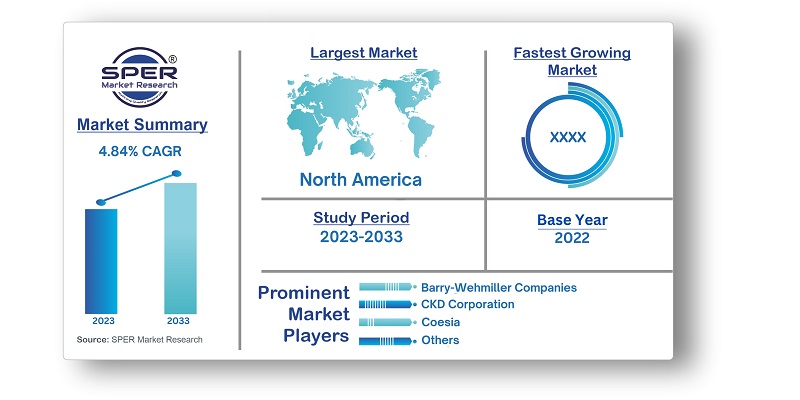
Packaging Machinery Market Growth, Size, Trends, Revenue, Scope and Future Share 2033
Packaging Machinery Market Size- By Machine Type, By Technology, By Business, By End User, By Operations, By Distribution Channel- Regional Outlook, Competitive Strategies and Segment Forecast to 2033
| Published: Mar-2023 | Report ID: PACK2304 | Pages: 1 - 255 | Formats*: |
| Category : Packaging | |||


| Report Metric | Details |
| Market size available for years | 2019-2033 |
| Base year considered | 2022 |
| Forecast period | 2023-2033 |
| Segments covered | By Machine Type, By Technology, By Business, By End User, By Operations, By Distribution Channel |
| Regions covered | Asia-Pacific, Europe, Middle East and Africa, North America, Latin America |
| Companies Covered | Barry-Wehmiller Companies, CKD Corporation, Coesia, Douglas Machine Inc., Duravant, Fuji Machinery Co.,Ltd, I.M.A. Industria Macchine Automatiche S.P.A, KHS Group, Krones AG, Langley Holdings Plc, Maillis Group, ProMach, Robert Bosch Gmbh, Rovema GmbH, Sacmi, Syntegon Technology GmbH, Tetra Laval International S.A., The Adelphi Group Of Companies, Others. |
- Manufacturers and suppliers of packaging machinery
- Packaging companies and converters
- Food and beverage industry
- Pharmaceutical and healthcare industry
- Cosmetics and personal care industry
- E-commerce and retail sector
- Logistics and shipping companies
- Industrial and manufacturing sector
- Agriculture and horticulture industry
- Chemical and petrochemical industry
- Automotive and electronics industry
- Contract packaging and co-packing companies
- Global Packaging Machinery Market Value Share and Forecast, By Machine Type, 2023-2033
- Bottling Line
- Cartoning Machines
- Cleaning & Sterilizing Machines
- FFS (Form, Fill and Seal) Machines
- Filling Machines
- Labelling Machines
- Palletizing Machines
- Wrapping Machines
- Global Packaging Machinery Market Value Share and Forecast, By Technology, 2023-2033
- General Packaging
- Modified Atmosphere Packaging
- Vacuum Packaging
- Global Packaging Machinery Market Value Share and Forecast, By Business, 2023-2033
- Aftermarket
- OEM
- Global Packaging Machinery Market Value Share and Forecast, By End User 2023-2033
- Food and Beverages
- Industrial and Chemicals
- Personal Care
- Pharmaceuticals
- Asia-Pacific
- Europe
- Middle East & Africa
- North America
- Latin America
- Global Packaging Machinery Market Size (FY’2023-FY’2033)
- Overview of Global Packaging Machinery Market
- Segmentation of Global Packaging Machinery Market By Machine Type {Bottling Line, Cartoning Machines, Cleaning & Sterilizing Machines, FFS (Form, Fill and Seal) Machines, Filling Machines, Labelling Machines, Palletizing Machines, Wrapping Machines, Others}
- Segmentation of Global Packaging Machinery Market By Technology (General Packaging, Modified Atmosphere Packaging, Vacuum Packaging)
- Segmentation of Global Packaging Machinery Market By Business (Aftermarket, OEM)
- Segmentation of Global Packaging Machinery Market By End User (Food and Beverages, Industrial and Chemicals, Personal Care, Pharmaceuticals, Others)
- Segmentation of Global Packaging Machinery Market By Operations (Autonomous, Semi-Autonomous)
- Segmentation of Global Packaging Machinery Market By Distribution Channel (E-Commerce, Direct)
- Statistical Snap of Global Packaging Machinery Market
- Growth Analysis of Global Packaging Machinery Market
- Problems and Challenges in Global Packaging Machinery Market
- Competitive Landscape in the Global Packaging Machinery Market
- Impact of COVID-19 and Demonetization on Global Packaging Machinery Market
- Details on Recent Investment in Global Packaging Machinery Market
- Competitive Analysis of Global Packaging Machinery Market
- Key Players in the Global Packaging Machinery Market
- SWOT Analysis of Global Packaging Machinery Market
- Global Packaging Machinery Market Future Outlook and Projections (FY’2023-FY’2033)
- Recommendations from Analyst
1.1. Scope of the report1.2. Market segment analysis
2.1. Research data source2.1.1. Secondary Data2.1.2. Primary Data2.1.3. SPER’s internal database2.1.4. Premium insight from KOL’s2.2. Market size estimation2.2.1. Top-down and Bottom-up approach2.3. Data triangulation
4.1. Driver, Restraint, Opportunity and Challenges analysis4.1.1. Drivers4.1.2. Restraints4.1.3. Opportunities4.1.4. Challenges4.2. COVID-19 Impacts of the Global Packaging Machinery Market
5.1. SWOT Analysis5.1.1. Strengths5.1.2. Weaknesses5.1.3. Opportunities5.1.4. Threats5.2. PESTEL Analysis5.2.1. Political Landscape5.2.2. Economic Landscape5.2.3. Social Landscape5.2.4. Technological Landscape5.2.5. Environmental Landscape5.2.6. Legal Landscape5.3. PORTER’s Five Forces5.3.1. Bargaining power of suppliers5.3.2. Bargaining power of buyers5.3.3. Threat of Substitute5.3.4. Threat of new entrant5.3.5. Competitive rivalry5.4. Heat Map Analysis
6.1. Global Packaging Machinery Market Manufacturing Base Distribution, Sales Area, Product Type6.2. Mergers & Acquisitions, Partnerships, Product Launch, and Collaboration in Global Packaging Machinery Market
7.1. Global Packaging Machinery Market Value Share and Forecast, By Machine Type, 2023-20337.2. Bottling Line7.3. Cartoning Machines7.4. Cleaning & Sterilizing Machines7.5. FFS (Form, Fill and Seal) Machines7.6. Filling Machines7.7. Labelling Machines7.8. Palletizing Machines7.9. Wrapping Machines7.10. Others
8.1. Global Packaging Machinery Market Value Share and Forecast, By Technology, 2023-20338.2. General Packaging8.3. Modified Atmosphere Packaging8.4. Vacuum Packaging
9.1. Global Packaging Machinery Market Value Share and Forecast, By Business, 2023-20339.2. Aftermarket9.3. OEM
10.1. Global Packaging Machinery Market Value Share and Forecast, By End User 2023-203310.2. Food and Beverages10.3. Industrial and Chemicals10.4. Personal Care10.5. Pharmaceuticals10.6. Others
11.1. Global Packaging Machinery Market Value Share and Forecast, By Operations, 2023-203311.2. Autonomous11.3. Semi-Autonomous
12.1. Global Packaging Machinery Market Value Share and Forecast, By Distribution Channel, 2023-203312.2. E-Commerce12.3. Direct
13.1. Global Packaging Machinery Market Size and Market Share
14.1. Global Packaging Machinery Market Size and Market Share By Machine Type (2019-2026)14.2. Global Packaging Machinery Market Size and Market Share By Machine Type (2027-2033)
15.1. Global Packaging Machinery Market Size and Market Share By Technology (2019-2026)15.2. Global Packaging Machinery Market Size and Market Share By Technology (2027-2033)
16.1. Global Packaging Machinery Market Size and Market Share By Business (2019-2026)16.2. Global Packaging Machinery Market Size and Market Share By Business (2027-2033)
17.1. Global Packaging Machinery Market Size and Market Share By End User (2019-2026)17.2. Global Packaging Machinery Market Size and Market Share By End User (2027-2033)
18.1. Global Packaging Machinery Market Size and Market Share By Operations (2019-2026)18.2. Global Packaging Machinery Market Size and Market Share By Operations (2027-2033)
19.1. Global Packaging Machinery Market Size and Market Share By Distribution Channel (2019-2026)19.2. Global Packaging Machinery Market Size and Market Share By Distribution Channel (2027-2033)
20.1. Global Packaging Machinery Market Size and Market Share By Region (2019-2026)20.2. Global Packaging Machinery Market Size and Market Share By Region (2027-2033)20.3. Asia-Pacific20.3.1. Australia20.3.2. China20.3.3. India20.3.4. Japan20.3.5. South Korea20.3.6. Rest of Asia-Pacific20.4. Europe20.4.1. France20.4.2. Germany20.4.3. Italy20.4.4. Spain20.4.5. United Kingdom20.4.6. Rest of Europe20.5. Middle East and Africa20.5.1. Kingdom of Saudi Arabia20.5.2. United Arab Emirates20.5.3. Rest of Middle East & Africa20.6. North America20.6.1. Canada20.6.2. Mexico20.6.3. United States20.7. Latin America20.7.1. Argentina20.7.2. Brazil20.7.3. Rest of Latin America
21.1. Barry-Wehmiller Companies21.1.1. Company details21.1.2. Financial outlook21.1.3. Product summary21.1.4. Recent developments21.2. CKD Corporation21.2.1. Company details21.2.2. Financial outlook21.2.3. Product summary21.2.4. Recent developments21.3. Coesia21.3.1. Company details21.3.2. Financial outlook21.3.3. Product summary21.3.4. Recent developments21.4. Douglas Machine Inc.21.4.1. Company details21.4.2. Financial outlook21.4.3. Product summary21.4.4. Recent developments21.5. Duravant21.5.1. Company details21.5.2. Financial outlook21.5.3. Product summary21.5.4. Recent developments21.6. Fuji Machinery Co. Ltd21.6.1. Company details21.6.2. Financial outlook21.6.3. Product summary21.6.4. Recent developments21.7. I.M.A. Industria Macchine Automatiche S.P.A21.7.1. Company details21.7.2. Financial outlook21.7.3. Product summary21.7.4. Recent developments21.8. KHS Group21.8.1. Company details21.8.2. Financial outlook21.8.3. Product summary21.8.4. Recent developments21.9. Krones AG21.9.1. Company details21.9.2. Financial outlook21.9.3. Product summary21.9.4. Recent developments21.10. Langley Holdings Plc21.10.1. Company details21.10.2. Financial outlook21.10.3. Product summary21.10.4. Recent developments21.11. Maillis Group21.11.1. Company details21.11.2. Financial outlook21.11.3. Product summary21.11.4. Recent developments21.12. ProMach21.12.1. Company details21.12.2. Financial outlook21.12.3. Product summary21.12.4. Recent developments21.13. Robert Bosch Gmbh21.13.1. Company details21.13.2. Financial outlook21.13.3. Product summary21.13.4. Recent developments21.14. Rovema GmbH21.14.1. Company details21.14.2. Financial outlook21.14.3. Product summary21.14.4. Recent developments21.15. Sacmi21.15.1. Company details21.15.2. Financial outlook21.15.3. Product summary21.15.4. Recent developments21.16. Syntegon Technology GmbH21.16.1. Company details21.16.2. Financial outlook21.16.3. Product summary21.16.4. Recent developments21.17. Tetra Laval International S.A.21.17.1. Company details21.17.2. Financial outlook21.17.3. Product summary21.17.4. Recent developments21.18. The Adelphi Group Of Companies21.18.1. Company details21.18.2. Financial outlook21.18.3. Product summary21.18.4. Recent developments21.19. Others
SPER Market Research’s methodology uses great emphasis on primary research to ensure that the market intelligence insights are up to date, reliable and accurate. Primary interviews are done with players involved in each phase of a supply chain to analyze the market forecasting. The secondary research method is used to help you fully understand how the future markets and the spending patterns look likes.
The report is based on in-depth qualitative and quantitative analysis of the Product Market. The quantitative analysis involves the application of various projection and sampling techniques. The qualitative analysis involves primary interviews, surveys, and vendor briefings. The data gathered as a result of these processes are validated through experts opinion. Our research methodology entails an ideal mixture of primary and secondary initiatives.



Frequently Asked Questions About This Report
PLACE AN ORDER
Year End Discount
Sample Report
Pre-Purchase Inquiry
NEED CUSTOMIZATION?
Request CustomizationCALL OR EMAIL US
100% Secure Payment






Related Reports
Our Global Clients
Our data-driven insights have influenced the strategy of 200+ reputed companies across the globe.






















